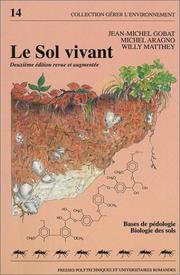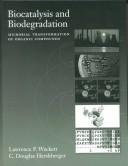| Listing 1 - 10 of 45 | << page >> |
Sort by
|

ISBN: 2880745012 9782880745011 Year: 2003 Volume: 14 Publisher: Lausanne : Presses Polytechniques et Universitaires Romandes,
Abstract | Keywords | Export | Availability | Bookmark
 Loading...
Loading...Choose an application
- Reference Manager
- EndNote
- RefWorks (Direct export to RefWorks)
soil science --- Biologie du sol --- Détoxification --- Detoxification --- Soil science. --- Soil biology. --- Soil biology --- ecology --- Soil sciences --- Soil pollution --- terminology --- Detoxification.

ISBN: 1555811795 9781555811792 Year: 2001 Publisher: Washington : ASM Press,
Abstract | Keywords | Export | Availability | Bookmark
 Loading...
Loading...Choose an application
- Reference Manager
- EndNote
- RefWorks (Direct export to RefWorks)
Biodegradation. --- Biotransformation (Metabolism) --- Organic compounds --- Biodégradation --- Biotransformation (Métabolisme) --- Biodegradation --- Composé organique --- organic compounds --- Contamination chimique --- Chemical contamination --- Détoxification --- Detoxification --- Micro-organisme --- microorganisms --- Propriété des micro-organismes --- Microbial properties --- Biotransformation (Metabolism). --- Biodégradation --- Biotransformation (Métabolisme) --- Detoxification. --- Organic compounds - Biodegradation
Multi
ISBN: 9054858842 Year: 1998 Publisher: Wageningen : Landbouwuniversiteit Wageningen,
Abstract | Keywords | Export | Availability | Bookmark
 Loading...
Loading...Choose an application
- Reference Manager
- EndNote
- RefWorks (Direct export to RefWorks)
Déchet solide --- Solid wastes --- Ordures ménagères --- Household wastes --- Métal lourd --- Heavy metals --- Gestion des déchets --- Waste management --- Utilisation des déchets --- Waste utilization --- Détoxification --- Detoxification --- Modèle --- Models --- Biotechnologie --- Biotechnology --- Agrotechnology and Food Sciences. Engineering --- Waste treatment --- Waste treatment. --- Detoxification.
Book
ISBN: 9789044725414 Year: 2009 Publisher: Aartselaar Deltas
Abstract | Keywords | Export | Availability | Bookmark
 Loading...
Loading...Choose an application
- Reference Manager
- EndNote
- RefWorks (Direct export to RefWorks)
Detoxification (Substance abuse treatment) --- Popular works --- Alcohol --- Physiological effect --- Hangover cures
Book
ISBN: 1316496821 1316497488 1316497151 1316498808 1316411419 1107126975 1107565731 1316494519 9781316411414 9781316498804 9781316497487 9781107126978 9781107565739 9781316496824 9781316497159 9781107126978 9781107565739 Year: 2016 Publisher: Cambridge, United Kingdom
Abstract | Keywords | Export | Availability | Bookmark
 Loading...
Loading...Choose an application
- Reference Manager
- EndNote
- RefWorks (Direct export to RefWorks)
Toxic Histories combines social, scientific, medical and environmental history to demonstrate the critical importance of poison and pollution to colonial governance, scientific authority and public anxiety in India between the 1830s and 1950s. Against the background of India's 'poison culture' and periodic 'poison panics', David Arnold considers why many familiar substances came to be regarded under colonialism as dangerous poisons. As well as the criminal uses of poison, Toxic Histories shows how European and Indian scientists were instrumental in creating a distinctive system of forensic toxicology and medical jurisprudence designed for Indian needs and conditions, and how local, as well as universal, poison knowledge could serve constructive scientific and medical purposes. Arnold reflects on how the 'fear of a poisoned world' spilt over into concerns about contamination and pollution, giving ideas of toxicity a wider social and political significance that has continued into India's postcolonial era.
Toxins --- Natural toxicants --- Toxicants, Natural --- Toxins and antitoxins --- Antigens --- Metabolites --- Poisons --- Antitoxins --- Detoxification (Health) --- History.
Book
ISBN: 3038428620 Year: 2018 Publisher: Basel, Switzerland : MDPI,
Abstract | Keywords | Export | Availability | Bookmark
 Loading...
Loading...Choose an application
- Reference Manager
- EndNote
- RefWorks (Direct export to RefWorks)
Venoms from marine and terrestrial animals (cone snails, scorpions, spiders, snakes, centipedes, cnidarian, etc.) can be seen as untapped cocktails of biologically active compounds that are being increasingly recognized as a new emerging source of peptide-based therapeutics. Venomous animals are considered to be specialized predators that have evolved the most sophisticated peptide chemistry and neuropharmacology for their own biological purposes by producing venoms that contain a structural and functional diversity of neurotoxins. These neurotoxins appear to be highly selective ligands for a wide range of ion channels and receptors. Therefore, they represent interesting lead compounds for the development of analgesics, anti-cancer drugs, drugs for neurological disorders such as multiple sclerosis, Parkinson' s disease, Alzheimer' s disease, and other therapeutics. This Special Issue of Toxins aims to provide a comprehensive look at toxins and toxin-inspired leads and will focus on the mechanisms of action, structure-function relationships, and evolution of pharmacologically interesting venom components, including the most recent developments related to the emergence of venoms as an underutilized source of highly evolved bioactive peptides with clinical potential.
Toxins. --- Natural toxicants --- Toxicants, Natural --- Toxins and antitoxins --- Antigens --- Metabolites --- Poisons --- Antitoxins --- Detoxification (Health)
Book
ISBN: 3036570918 303657090X Year: 2023 Publisher: Basel, Switzerland : MDPI - Multidisciplinary Digital Publishing Institute,
Abstract | Keywords | Export | Availability | Bookmark
 Loading...
Loading...Choose an application
- Reference Manager
- EndNote
- RefWorks (Direct export to RefWorks)
The lifestyle associated with good quality of food is well known for its widely recognized health benefits, especially when rich in bioactive compounds. Reduced risks of some types of cancer and other diseases have been associated with the adoption of such a diet, as have increased antioxidants, inhibitors of lipid peroxidation, decrease of pro-inflammatory cytokine production, etc. The focus of this Special Issue of Toxins was to gather advances related to the cytotoxicity of natural toxins and the potential for the cytoprotection of natural compounds present in food or plants. In this context, this Special Issue of Toxins comprises eight original contributions. Special attention is given to Fridericia chica (Bignoniaceae) leaves grown in Colombia, extract from Polygonum cuspidatum, Artemisia annua and coffee extracts against mycotoxins ́ effects. Studies of mycotoxins in different animal and human cell lines are also presented for zearalenone, beauvericin, α-zearalenol and β-zearalenol, among others.
Toxins. --- Natural toxicants --- Toxicants, Natural --- Toxins and antitoxins --- Antigens --- Metabolites --- Poisons --- Antitoxins --- Detoxification (Health)
Book
ISBN: 3036569057 3036569049 Year: 2023 Publisher: Basel, Switzerland : MDPI - Multidisciplinary Digital Publishing Institute,
Abstract | Keywords | Export | Availability | Bookmark
 Loading...
Loading...Choose an application
- Reference Manager
- EndNote
- RefWorks (Direct export to RefWorks)
Toxins are biologically active substances produced by most kinds of living organisms, bacteria, fungi, plants, and animals. They present a vast diversity of molecular structures and target a wide variety of receptors involved in a range of physiological processes. As toxins are selected during evolution to acquire/improve their disabling/lethal effects, they display finely tuned functional properties often associated with high affinities and selectivity. Moreover, toxins are valuable tools to unravel cellular processes due to their extreme specificity for cell surface and/or intracellular targets. Therefore, toxins are very attractive compounds because of their Janus-like character; while they mostly act as deadly poisons like monstrous Mr. Hyde, they can also be tamed into good remedies like admirable Dr. Jekyll. As such, they have been primarily investigated not only for the light they can throw on fundamental physiological processes but also for their potential therapeutic applications. This book, emerging from the 27th Annual Meeting of the French Society of Toxinology (SFET, http:sfet.asso.fr/international), will be of great interest for those in the scientific community who want to know more about the fascinating world of toxins.
Toxins. --- Natural toxicants --- Toxicants, Natural --- Toxins and antitoxins --- Antigens --- Metabolites --- Poisons --- Antitoxins --- Detoxification (Health)
Book
ISBN: 0849355249 Year: 1982 Publisher: Boca Raton (Fla.) : CRC press,
Abstract | Keywords | Export | Availability | Bookmark
 Loading...
Loading...Choose an application
- Reference Manager
- EndNote
- RefWorks (Direct export to RefWorks)
Environmental Sciences and Forestry. Environmental Management --- Microbial metabolism. --- Pollutants --- Pollutants --- Xenobiotics --- Environmental Pollution. --- Biodegradation. --- Metabolic detoxification. --- Metabolism.
Dissertation
Abstract | Keywords | Export | Availability | Bookmark
 Loading...
Loading...Choose an application
- Reference Manager
- EndNote
- RefWorks (Direct export to RefWorks)
Proefschriften --- Thèses --- Eau souterraine --- groundwater --- Pollution de l'eau --- Water pollution --- Pollution du sol --- Soil pollution --- Hydrocarbure --- Hydrocarbons --- Détoxification --- Detoxification --- Propriété des micro-organismes --- Microbial properties --- PCR --- Écologie microbienne --- microbial ecology --- Bacteria --- Identification --- identification --- Génotype --- genotypes --- Surveillance --- monitoring --- Theses --- Detoxification. --- identification.
| Listing 1 - 10 of 45 | << page >> |
Sort by
|

 Search
Search Feedback
Feedback About UniCat
About UniCat  Help
Help News
News